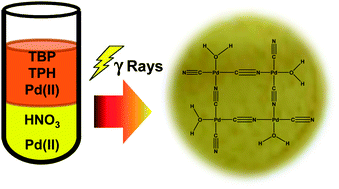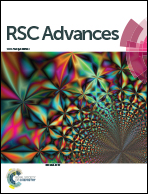Characterization of palladium species after γ-irradiation of a TBP–alkane–Pd(NO3)2 system†
Abstract
The γ-irradiation of a biphasic system composed of tri-n-butylphosphate in tetrapropylene hydrogen (TPH) in contact with palladium(II) nitrate in nitric acid aqueous solution led to the formation of two precipitates. A thorough characterization of these solids was performed by means of various analytical techniques including X-Ray Diffraction (XRD), Thermal Gravimetric Analysis coupled with a Differential Scanning Calorimeter (TGA-DSC), X-ray Photoelectron Spectroscopy (XPS), InfraRed (IR), RAMAN and Nuclear Magnetic Resonance (NMR) Spectroscopy, and ElectroSpray Ionization Mass Spectrometry (ESI-MS). Investigations showed that the two precipitates exhibit quite similar structures. They are composed at least of two compounds: palladium cyanide and palladium species containing ammonium, phosphorous or carbonyl groups. Several mechanisms are proposed to explain the formation of Pd(CN)2.



 Please wait while we load your content...
Please wait while we load your content...